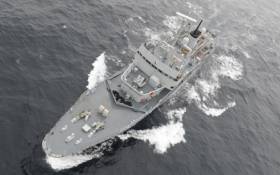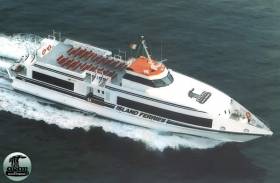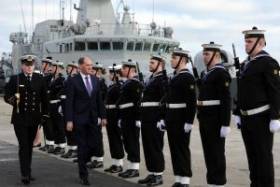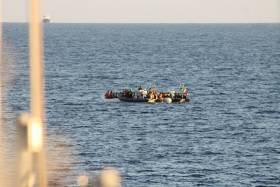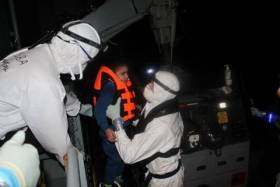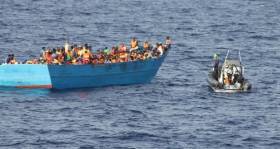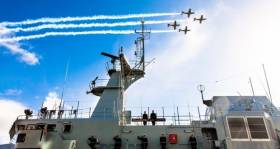Displaying items by tag: Navy
Supertrawler Boarded For Inspection Off Donegal
#Supertrawler - Naval Service personnel from the LÉ James Joyce have boarded a controversial fishing ‘supertrawler’ off the North West coast, according to the Donegal Democrat.
As previously reported on Afloat.ie, the 9,500-tonne FV Margiris — one of the largest fishing vessels in the world — prompted renewed fears among local fisherman and conservationists last week when it was spotted in fishing grounds off Donegal.
News of the Naval Service inspection has been welcomed by the Irish Wildlife Trust, though it cautioned on the need for a full-time inspection regime for such large-scale factory trawlers to ensure they are fishing legally and within quota, and not causing harm to protected wildlife such as dolphins.
The Donegal Democrat has more on the story HERE.
LE Aisling As Museum Considered In Government Proposal
#AislingsFuture - A decommissioned Naval Service ship may be turned into a museum in Galway, writes The Connacht Tribune.
The idea of using the LÉ Aisling as a visitor attraction in the city, has been floated with Government.
Paul Kehoe, Junior Minister at the Department of Defence, this week said the request is “under consideration”.
The ship, which had been twinned with Galway City for almost 20 years, has travelled 628,856 nautical miles, the equivalent of travelling around the world more than 32 times.
It was decommissioned at a ceremony in Galway Harbour in June after 36 years of service to the State.
At the time, City Councillor Pearce Flannery (FG), the deputy mayor, suggested it could be used as a floating museum in Galway Harbour or off Salthill.
Minister Kehoe this week said he would soon make a decision as what to do with the LÉ Aisling. To read more click here.
Naval Service Examined As Possible Short Term Solution of Ferry Crisis to Largest of Aran Islands
#AranIslands - The use of the Irish Naval Service to provide a short-term service to residents on Inis Mór (largest of the Oileán Árann /Aran Islands) is being explored by Gaeltacht Minister Sean Kyne.
As Galway Bay FM reports the proposal follows the planned withdrawal of the winter service to the largest Aran Island until March 2017, with the last ferry set to depart at 6pm this evening (yesterday, 30th November).
Operator Island Ferries Teoranta has reaffirmed it’s intention to suspend the service – citing the ‘negative fiscal conditions’ created by the local authority with the introduction of passenger levies.
For more on the developing story, click here.
Afloat.ie adds that vital sea transportation links to Inis Mór are still been maintained albeit by a cargo-only operator, Lasta Mara Teoranta. This company serves the three islands from the mainland not just out of Rossaveel in Connemara but also Galway Port.
As of this morning Afloat.ie monitored their coastal freighter MV Bláth na Mara that departed Inis Oirr bound for Galway Port's outer pier. This is the final leg of a round trip that previously included calls firstly to Inis Mór followed by Inis Meáin.
Another crises that faced islanders was in August when Lasta Mara's other freight ro-ro vessel MV Chateau-Thierry came to the aid of two of three islands with generators that were used to restore electricity. This followed power-cuts caused by a damaged subsea cable connecting the mainland.
New International Service Medals Presented to Naval Service Crew Members
#NewMedals – New International Operational Service Medals were presented to members of the Defence Forces by Minister Paul Kehoe in Dun Laoghaire Harbour at the weekend, writes Jehan Ashmore.
The medals are in recognition of their humanitarian missions overseas which included Naval Service crew members that were deployed to the Mediterranean Sea due to the migrant refugee crisis. Other members of the Defence Forces that were deployed for example in Sierra Leone, west Africa were also awarded medals.
To mark the occasion that took place on Saturday at the Carlisle Pier was berthed LE James Joyce (P62). The offshore patrol vessel (OPV) had taken part in Operation Pontus during her Mediterranean deployment until replaced in September by a sister LE Samuel Beckett.
Less than 48 hours after the award ceremony LE Samuel Beckett rescued more than 500 migrants off the Libyan coast.
LE Samuel Beckett Rescues More than 500 Migrants
#MigrantsRescue - LÉ Samuel Beckett located and rescued a total of 508* migrants from four separate rubber vessels in the early hours of yesterday morning.
The search and rescue operation according to the Naval Service took place 50 nautical miles NW off Tripoli, Libya and was at the request of the Italian Maritime Co-Ordination Centre.
The first rescue operation began at 02.20am and all migrants were taken on board LÉ Samuel Beckett by 12.20pm. The 508* migrants received food, water and medical treatment where required.
This brings to 2,818* migrants rescued by the LÉ Samuel Beckett since it deployed to the area of operations on 23rd September of this year.
LÉ Samuel Beckett will now bring all rescued persons to a designated Port of Safety.
*Figures for the operation are provisional until confirmed by the Italian authorities.
Defence Forces International Operational Service Medal Ceremony to take Place in Dun Laoghaire
#ServiceMedal - International Operational Service Medals are to be presented to members of the Permanent Defense Force at a ceremony held in Dun Laoghaire Harbour.
The ceremony on Carlisle Pier (12 noon Saturday, 26 November) is in recognition of their humanitarian mission overseas. To mark the occasion the Naval Service OPV LE James Joyce (P62) will be berthed alongside.
The event will not be open the public but can be viewed from the Harbour Plaza next to the former ferry terminal or the East Pier.
LE James Joyce is the fifth Naval Service vessel to have been deployed since the Irish State joined the Mediterranean mission in May last year. By early September, sixteen bodies were recovered by the 59-strong crew and a total of 1,882 migrants including 56 children were rescued.
Last year the €50m OPV90 class newbuild was docked at Carlisle Pier having been named by Ms Carol Joyce who is a grand-niece of James Joyce.
Search And Rescue of Almost 100 Migrant Refugees Tasked to LÉ Samuel Beckett
#MigrantRescues – Two search and rescue missions (SAR) tasked by LÉ Samuel Beckett last week saved almost 100 migrant refugees off the Libyan coast.
According to the Naval Service the most recent SAR took place on Friday night following a request from the Italian Maritime Rescue Co-Ordination Centre. LÉ Samuel Beckett located and rescued a total of 50* migrants from a rubber 25 nautical miles north-west of Tripoli. The rescue operation began at 8.05pm and all migrants were taken on board LÉ Samuel Beckett by 10.20pm. The rescued persons were transferred to the NGO vessel Bourbon Argos.
Three days previously on the Tuesday, LÉ Samuel Beckett was also deployed by the Italian authorities to locate a total of 40* migrants. Again this incident involved a rubber vessel during a the rescue operation that was conducted 44 nautical miles north east off the Libyan capital. The operation began at 11am and all migrants were taken on board the OPV90 class vessel by 1.30pm. The 40 rescued persons were transferred to another NGO vessel, the Aquarius.
This brings to 2,310* migrants rescued by the LÉ Samuel Beckett since it deployed to the Mediterranean area of operations on 23 September of this year.
*Figures released on the days for both SAR operations are provisional until confirmed by the Italian authorities.
#BusyBeckett - In the space of two days, LÉ Samuel Beckett has carried out three separate rescue operations involving more than 400 people in the Mediterranean off north Africa.
The first incident took place yesterday, almost 40 nautical miles off the Libyan capital, Tripoli, following a request from the Italian Maritime Rescue Co-Ordination Centre. This is where the Irish Naval Service OPV90 class vessel located and rescued a total of 299* migrants from three separate rubber vessels during search and rescue (SAR) operations.
The first rescue operation began at 08.50am and all migrants were taken on board LÉ Samuel Beckett by 12.15pm. The migrants received food, water and medical treatment where required.
On the previous day, Wednesday, LÉ Samuel Beckett carried out another SAR which saw 122* migrants from a rubber vessel again in the same area north east of Tripoli. The rescue operation began at 8.00am and all migrants were taken on board LÉ Samuel Beckett by 12.30pm. Likewise migrants recieved assistance including medical treatment where required.
LÉ Samuel Beckett transferred all rescued persons to the VOS Hestia. This vessel transported them to a port of safety and from there they were administered by Italian authorities.
*Figures for both SAR operations are provisional until confirmed by the Italian authorities.
More Than 700 Migrants Rescued by LÉ Samuel Beckett off Libya
#MigrantsRescued - A total 772 migrants were rescued by LÉ Samuel Beckett from a large wooden barge during a “complex search and rescue operation” off the coast of Tripoli, Libya.
The operation writes The Irish Times was carried out on Friday following a call for assistance from the Italian Maritime Rescue Co-Ordination Centre.
The Irish Naval Service vessel located and rescued the migrants from the barge about 36 nautical miles (67km) northeast of the Libyan capital.
Afloat adds that it is a month ago since the OPV90 leadship departed Cork Harbour on the deployment to provide humanitarian duties.
#HospitalShip - The Naval Service have plans for a newbuild which would be equipped to provide full medical facilities at sea have been endorsed by Taoiseach Enda Kenny.
The Irish Times writes that a White Paper on Defence promises a multi-purpose vessel equipped with a fully functioning hospital, Mr Kenny said in Galway docks on Monday.
This would allow medical personnel to serve in “war and conflict situations”, Mr Kenny said. He was speaking at the commissioning of the Naval Service’s latest new patrol ship, LÉ William Butler Yeats.
Mr Kenny said it was “his wish” that such a multi-purpose ship – still at pre-design stage – would be built to serve in humanitarian crises. It was in “keeping with our rich tradition of charity and volunteering”, he said.
For more on search and rescues in the Mediterranean and the ceremony for the newbuild held at Galway Port, click here.



























